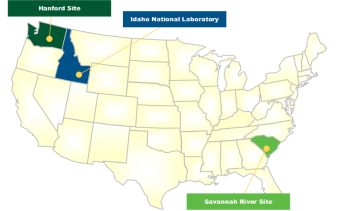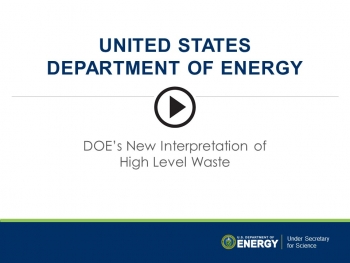HLW Interpretation News
Finding of No Significant Impact, Final Environmental Assessment, and Technical Documents
Finding of No Significant Impact (FONSI) and Final Environmental Assessment (Final EA)
DOE issued two National Environmental Policy Act (NEPA) documents, the FONSI and the Final EA that show Defense Waste Processing Facility (DWPF) recycle wastewater from the Savannah River Site (SRS) can be safely disposed of as low-level radioactive waste (LLW) at a commercial facility outside of the state of South Carolina. The Final EA contains responses to public comments received on the Draft EA.
Technical Documents
Waste Determination & Technical Evaluation for Non-High-Level Radioactive Waste (Non-HLW) Determination under the HLW Interpretation: Commercial Disposal of Defense Waste Processing Facility Recycle Wastewater from the Savannah River Site (Technical Evaluation): These documents demonstrate that up to 8 gallons of stabilized DWPF recycle wastewater meets the HLW interpretation for classification as non-HLW.
Technical Justification for an Exemption from Application of Waste Incidental to Reprocessing Criteria in DOE Manual 435.1-1, Radioactive Waste Management Manual for Savannah River Site Defense Waste Processing Facility Recycle Wastewater (Exemption to DOE Manual 435.1-1): This document provides the technical justification for an Exemption from the Waste Incidental to Reprocessing requirements contained in the Department of Energy’s Manual 435.1-1, Radioactive Waste Management Manual, Chapter II, Section B.
Informational Webinar on DWPF Recycle Wastewater
On September 10, 2020, DOE held an informational webinar on DWPF recycle wastewater technical documents (Waste Determination, Technical Evaluation, and Exemption to DOE Manual 435.1-1), Final EA, and FONSI. Read the presentation here.
DWPF Recycle Wastewater Fact Sheets
- Classifying Radioactive Tank Waste
- Finding of No Significant Impact and Final Environmental Assessment for the Commercial Disposal of Defense Waste Processing Facility Recycle Wastewater from the Savannah River Site
- Packaging and Transportation
- Packaging and Transportation Safeguards for Shipment of Liquid Low-Level Radioactive Waste
Draft Environmental Assessment
DOE issued the Draft Environmental Assessment for the Commercial Disposal of Defense Waste Processing Facility Recycle Wastewater from the Savannah River Site (Draft EA) via a Federal Register Notice (FRN). DOE invited public comments on the Draft EA. On December 30, 2019, DOE announced in the Federal Register (84 FR 71909) that, in response to stakeholder requests, the original 30-day public comment period was extended to February 10, 2020 (i.e., an extension of 32 days).
DOE held an informational meeting in Augusta, GA, on December 17, 2019 and an informational internet webinar on December 19, 2019 to present an overview of the Draft EA and the Department's HLW Interpretation.
Draft EA presentation for December 17, 2019 informational meeting
Draft EA presentation for December 19, 2019 informational internet webinar meeting
HLW Interpretation presentation for December 17 and 19, 2019 meetings
HLW Interpretation Overview
HLW Interpretation Background
On October 10, 2018, The Department of Energy (DOE) issued the Federal Register Notice, Request for Public Comment on the U.S. Department of Energy Interpretation of High-Level Radioactive Waste (83 FR 50909), on its interpretation of the definition of the statutory term “high-level radioactive waste” (HLW) as set forth in the Atomic Energy Act of 1954, as amended (AEA), and the Nuclear Waste Policy Act of 1982, as amended (NWPA). A 90-day comment period, including a 30-day extension to submit comments, invited public input in order to better understand stakeholder perspectives, and to increase transparency and enhance public understanding of this issue. DOE received a total of 5,555 comments, roughly 360 of which were distinct, unrepeated comments, from a variety of stakeholders: members of the public, Native American tribes, members of Congress, numerous state and local governments, and one federal agency, the Nuclear Regulatory Commission.
On June 5, 2019, DOE issued the Supplemental Notice Concerning U.S. Department of Energy Interpretation of High-Level Radioactive Waste. As DOE stated in the October 10 Notice and reiterated in the Supplemental Notice, DOE interprets the statutory term such that some reprocessing wastes may be classified as not HLW (non-HLW) and may be disposed of in accordance with its radiological characteristics. The Supplemental Notice provided additional explanation of DOE’s interpretation as informed by public review and comment.
DOE has not made, and does not presently propose, any changes or revisions to current policies, legal requirements or agreements with respect to HLW. Decisions about whether and how this interpretation of HLW will apply to existing wastes and whether such wastes may be managed as non-HLW will be the subject of subsequent actions.
On June 5, 2019, DOE issued the Federal Register Notice, Environmental Assessment for the Commercial Disposal of Defense Waste Processing Facility Recycle Wastewater from the Savannah River Site, that informs the public that DOE will be drafting an Environmental Assessment, a form of National Environmental Policy Act of 1969 analysis, on a waste stream at the Savannah River Site.
HLW Definition and DOE’s Interpretation
The AEA and NWPA define the term “high-level radioactive waste” as:
(A) the highly radioactive material resulting from the reprocessing of spent nuclear fuel, including liquid waste produced directly in reprocessing and any solid material derived from such liquid waste that contains fission products in sufficient concentrations; and
(B) other highly radioactive material that the [Nuclear Regulatory] Commission, consistent with existing law, determines by rule requires permanent isolation.
DOE has revised its interpretation, as stated in its October 10, 2018, Federal Register Notice, after consideration of public comments. Based on those comments, DOE interprets the statutes to provide that a reprocessing waste may be determined to be non-HLW if the waste meets either of the following two criteria:
I) does not exceed concentration limits for Class C low-level radioactive waste as set out in section 61.55 of title 10, Code of Federal Regulations, and meets the performance objectives of a disposal facility; or
II) does not require disposal in a deep geologic repository and meets the performance objectives of a disposal facility as demonstrated through a performance assessment conducted in accordance with applicable requirements.
Current Locations for DOE Defense Reprocessing Waste Inventories

DOE Reprocessing Waste Inventory
Reprocessing of spent nuclear fuel began in the 1940s and continued through much of the Cold War as part of the development of nuclear weapons. Weapons development activities occurred primarily at the Hanford Site in Washington and the Savannah River Site in South Carolina. Reprocessing activities supporting nuclear research and development (R&D) and naval propulsion programs occurred at the Idaho National Laboratory. Reprocessing waste from West Valley, New York, is not included in this inventory of defense waste. The West Valley Demonstration Project operates under a distinct statutory and regulatory basis pursuant to the West Valley Demonstration Project Act (Public Law 96-368), which provides a definition of HLW separate from the AEA and the NWPA.
Each reprocessing waste stream has unique radiological characteristics -- therefore, the HLW interpretation will be implemented on a site-specific and waste stream-specific basis. The map below identifies sites with reprocessing waste potentially impacted by the HLW interpretation.
Benefits
The HLW interpretation, if implemented through subsequent actions, could provide a range of benefits to both DOE and the public, including:
- Reducing the length of time that radioactive waste is stored on-site at DOE facilities, increasing safety for workers, the public, and the environment.
- Removing reprocessing waste from the States where it has been stored for decades and providing for the disposal of these wastes in facilities constructed and regulated for such purposes.
- Enhancing safety at DOE sites by using lower-complexity waste treatment and immobilization approaches.
- Aligning the U.S. with international guidelines for management and disposal of radioactive waste based on radiological risk.
- Utilizing mature and available commercial facilities and capabilities to shorten mission completion schedules and reduce taxpayer financial liability.
All product and company names used on this site are the trademarks of their respective holders. Reference herein to any specific commercial company, product, process, or service by trade name, trademark, manufacturer, or otherwise, does not necessarily constitute or imply its endorsement, recommendation, or favoring by the United States Government or any agency thereof or its contractors or subcontractors.

